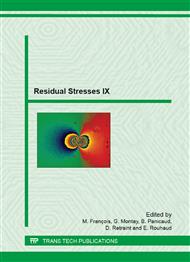p.775
p.782
p.788
p.794
p.801
p.808
p.814
p.820
p.827
On Welding Residual Stresses Near Fatigue Crack Tips
Abstract:
Residual stresses in welded joints are supposed to change during fatigue loading. Residual stresses can be, depending on the loading conditions, relaxed as well as build up and they can be affected by fatigue crack growth. Furthermore residual stresses are supposed to affect the fatigue strength of welded steel structures. However, tensile residual stresses decrease and compressive residual stresses increase the fatigue strength. This residual stress effect on the fatigue strength is mostly explained with different crack propagation rates.The presented work is on welded longitudinal stiffeners, made of unalloyed fine grained carbon steel, with different fatigue crack lengths in which residual stresses have been determined. The residual stress measurement was conducted using Neutron diffraction. The results of the diffraction measurement show that the initial tensile residual stresses near the weld toe are, caused by phase transformation at low temperatures, below the base materials yield strength. Tensile residual stresses in the order of the yield strength can be found below the materials surface. These areas of high residual stresses are moving with the propagating crack tip through the specimen during fatigue loading.
Info:
Periodical:
Pages:
801-807
Citation:
Online since:
August 2014
Authors:
Keywords:
Permissions:
Share:
Citation:


